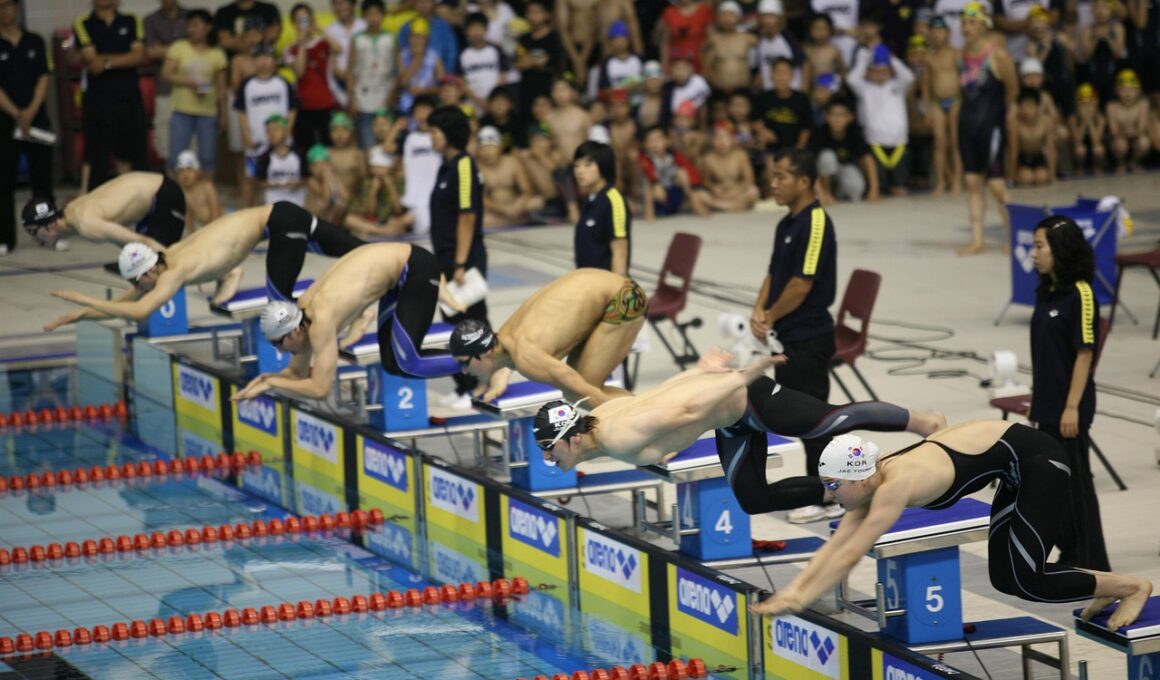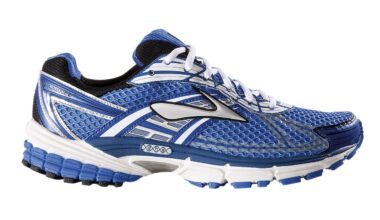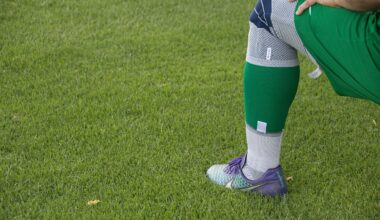Plyometric Techniques for Swimmers: Improving Start and Turns
Plyometric training can substantially enhance swimming performance, particularly for starts and turns. Utilizing explosive movements, swimmers can develop the power needed to push off walls or dive into the water vigorously. Plyometrics incorporates different drills to improve agility, strength, and overall speed, which are critical during competitive swimming. A tailored plyometric program can focus on areas such as reaction time and resistance to muscle fatigue. These workouts should include exercises like box jumps, depth jumps, and plyometric push-ups. Box jumps help in building lower-body explosiveness, while depth jumps enhance the stretch-shortening cycle crucial for swimming starts. Additionally, these exercises strengthen specific muscle groups used in swimming while improving coordination. Generally, a structured program should focus on technique first before increasing intensity and volume. Swimmers of all levels can benefit from including plyometric training in their regimen, as it allows them to optimize their performance during races. To create an effective training program, swimmers should consult with a coach or trainer familiar with plyometric techniques specific to their swimming styles.
Benefits of Plyometrics for Swimmers
Engaging in plyometric exercises offers numerous benefits specific to swimming, especially regarding starts and turns. These exercises improve muscle coordination, which is vital for an efficient start. Enhanced coordination leads to smoother transitions between the underwater phase and surface swimming. Moreover, plyometrics facilitate greater explosive power, directly impacting how quickly a swimmer can accelerate off the blocks. Other advantages include improved body awareness, or proprioception, which enhances stability and control during rotations. With better control, swimmers can execute faster and more precise turns, reducing their time spent at the wall. Incorporating these drills into a training routine promotes faster recovery, as the body adapts to exerting maximum effort in quick bursts. Additionally, this style of training can elevate cardiovascular endurance, allowing swimmers to maintain high-intensity efforts through longer sets and races. Building strength through consistent plyometric workouts decreases the likelihood of injury by ensuring that muscles, tendons, and ligaments are well-conditioned. Overall, these benefits not only improve start and turn performance but also contribute to overall swimmer competence and competitiveness.
To integrate plyometric exercises effectively into a swimming regimen, it’s essential to prescribe a suitable frequency, intensity, and volume. Typically, swimmers should perform plyometric workouts two to three times per week, taking care not to overload their systems. The exercises must be progressive, emphasizing form and technique before moving up in intensity or complexity. For younger or novice swimmers, focusing more on lower-intensity exercises may help them adapt better to the movements. Once the basics are mastered, more challenging variations like single-leg hops or lateral bounds can be introduced. Each training session should start with an adequate warm-up, preparing the muscles and minimizing the risk of injuries. After training, including a cooldown period with stretching or mobility drills further aids recovery. Monitoring the swimmers’ signs of fatigue or pain is crucial; thus, rest days or reduced schedule sessions may be necessary to prevent any potential overtraining. Coaches can customize each session based on individual swimmer needs and capabilities. Regular assessments and feedback will ensure the training remains effective and beneficial for enhancing performance.
Type of Plyometric Exercises for Swimmers
Focusing on specific plyometric exercises can dramatically improve swimming efficiency and productivity. Some essential exercises include squat jumps, bench throws, and medicine ball chest passes, valuable for building explosive leg power. Squat jumps emphasize vertical force, which directly applies to diving starts. On the other hand, bench throws and medicine ball work enhance upper body explosiveness, playing a vital role during a swimmer’s powerful arm pulls. Another effective exercise is the ankle hop, which targets explosiveness in the lower leg. For swimmers, executing these exercises in high repetitions can lead to increased overall muscle endurance, aligning well with the demands of competitive swimming. Furthermore, lateral plyometric exercises like lateral bounds and zigzag hops help improve agility and quick directional changes essential during flips and turns. The variety of movements ensures a comprehensive approach to muscle development. Incorporating these exercises consistently promotes not only greater power output but also overall athleticism. Transitioning to a swimming-specific training program, swimmers can track progress in drills to document improvement and ensure they are gaining athletic benefits. Regularly varying these exercises will accommodate progressive overload for optimal performance.
As swimmers focus on improving their explosive starts, it’s essential to integrate reaction drills in conjunction with plyometrics. Fast reactions can significantly enhance performance on the starting block. These agility drills can include shuttle runs or quick footwork training, enhancing speed and responsiveness to the starting signal. Optimal timing and accuracy during starts can determine race outcomes, so pairing these drills with plyometric training can yield impressive results. Implementing technology like starting blocks that measure reaction time can also provide valuable feedback for swimmers. This integration allows coaches and athletes to set tactical goals surrounding their starts. In swimming, the transition from the dive into the first stroke must be seamless and fast. The explosive nature of plyometric exercises reinforces these movements, creating muscle memory and improving overall performance. Furthermore, analyzing video footage from actual races can help swimmers understand their techniques better. By identifying areas needing improvement, they can adjust their training accordingly. Regular assessments throughout the season can motivate improved starts, ensuring swimming goals are achieved effectively while maintaining enthusiasm for training.
Monitoring Progress and Adjustments
Monitoring performance progress is fundamental when integrating plyometrics into a swimmer’s training plan. Maintaining a log of workouts, including sets, repetitions, and subjective rates of perceived exertion (RPE), helps coaches understand individual swimmer responses. Evaluating how swimmers feel during different intensities allows for timely adjustments to avoid overtraining or fatigue. A schedule of fitness assessments can help measure progress, from vertical jump height to reaction times off the starting blocks. Swimmers should be encouraged to articulate any challenges they face or areas of discomfort while carrying out plyometric exercises. Depending on these evaluations, coaches may need to make adjustments to the exercise selection, frequency, or intensity. Additionally, incorporating rest days or deloading weeks can offer relief to a swimmer’s body, allowing adaptation and recovery. Variation not only aids physical recovery but encourages psychological engagement in training. With proper adjustments based on feedback and performance metrics, swimmers will remain motivated and excited about their development. Therefore, the combination of consistent evaluation and modification paves the way for notable enhancements in swimming techniques and overall performance.
In conclusion, incorporating plyometric training into a swimmer’s routine can yield significant performance improvements, specifically in starts and turns. These explosive exercises build the necessary muscle strength and power, which leads to gains in overall swimming efficiency. Alongside traditional swim training, plyometric workouts create a comprehensive approach aimed at refining competitive skills. By prioritizing proper execution and progressing gradually, swimmers can maximize their results and minimize their risk of injury. Regular assessments and adjustable programming will ensure that the athletes are continually thriving, facing challenges with enthusiasm and improving performance. As swimmers refine their technique, the combination of strength, speed, and agility becomes crucial in dominating competitive events. The beauty of plyometrics lies in its adaptability; coaches can tailor methods to each swimmer’s specific needs and preferences. As athletes gain confidence in their abilities, they will see a direct correlation of these benefits during practice and competition. In the end, embracing plyometric training not only elevates a swimmer’s performance to higher levels but also enriches their overall experience in the sport.


